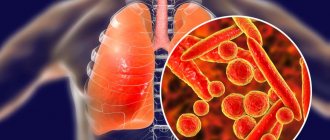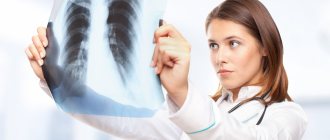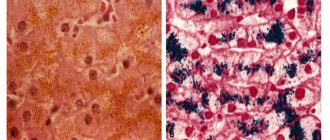Causes of pain in the lungs
Such concepts as lung pain or pain in the lungs do not exist from a medical point of view, since it is a paired organ and does not have nerves that could perceive pain.
But there are certain symptoms that, together with shortness of breath, cough and localized pain, will indicate certain diseases that do not always affect the lungs. Very often, pain in the lungs is accompanied by shortness of breath and cough . There are areas in the lungs where pain may occur - these are the trachea, pleura or bronchi.
For a successful diagnosis, the strength and nature of pain in the lungs, its localization, connection with shortness of breath and cough, and the effect of taking certain medications are of great importance. If severe pain is felt in the lungs, then most likely there is one of the acute diseases. Quite often, such pain occurs against the background of heavy breathing and intensifies with breathing, which indicates pleural pain.
If pain in the lungs is felt in the area behind the sternum and is pronounced, and even intensifies when coughing, then these are the first signs of tracheitis. An exciting symptom is chest pain, which is accompanied by difficulty breathing and is difficult to treat. Quite often, patients complain of pain in the lungs, which radiates to other organs: pain behind the sternum, as well as in the area of the heart, between the shoulder blades, or radiating to the left limb - this is a sign of possible coronary insufficiency.
Tuberculosis
Many are still confident that tuberculosis is a thing of the past, in history and in Remarque’s novels, says Arkady Vertkin. Unfortunately, it is not. Russia is in third place in terms of the prevalence of this disease.
Another incorrect belief is that tuberculosis is a disease of people of special social status (people without a fixed place of residence, migrants released from prison, alcohol and drug abusers).
“These are indeed risk groups for infection with this disease, but, unfortunately, due to its widespread prevalence, tuberculosis can be contracted regardless of belonging to any social group - just look at the patients in TB departments,” the professor notes.
Symptoms:
- prolonged dry cough;
- constant low-grade fever (increase in temperature from 37.0 °C to 37.9 °C) or an increase in body temperature in the morning with the evening temperature curve returning to normal;
- sweating, especially at night;
- weight loss with preserved appetite;
- weakness, fatigue;
- generalized or limited enlargement of lymph nodes;
- hemoptysis.
Treatment is required; there should be no self-help, only examination and therapy prescribed by a doctor, so as not to aggravate the situation.
What is COPD and how to cope with chronic bronchitis? More details
Diseases that cause pain in the lungs
Pain in the lungs is most often a manifestation of a certain disease, and ignoring such symptoms means not worrying about your health. People feel pain in different ways: sometimes they cut, sometimes they prick, sometimes they press. The location of the pain is also an important factor. By summing up all the symptoms of pain in the lungs, it is possible to make a correct diagnosis, since there are many diseases in which pain in the lungs is felt.
Diseases in which a person experiences pain in the lungs:
- Pneumonia;
- Bronchitis;
- Acute tracheitis;
- Lobar pneumonia;
- Pleurisy;
- Spontaneous pneumothorax;
- Lungs' cancer;
- Bronchial asthma;
- Pain of bone, joint or muscle origin;
- Heart diseases;
- Pericarditis;
- Pulmonary embolism;
- Aortic diseases;
- Pancreatitis;
- Stomach and duodenal ulcers;
- COPD
COPD
Chronic obstructive pulmonary disease (COPD) is a common disease that often affects smokers or former smokers. This disease develops slowly, so it usually appears only at the age of 40-50.
“If a person has COPD in an advanced stage, then it is difficult for him to do even simple, familiar things, for example, tie his shoelaces, lift a bag or bag of groceries, climb the stairs - such actions will cause shortness of breath,” says Arkady Vertkin.
Symptoms:
- cough daily, often in the first half of the day, rarely at night;
- sputum production of any nature;
- shortness of breath is constant, increasing with physical activity, respiratory infections;
- combination of cough and shortness of breath with prolonged exhalation;
- wheezing.
Hard breath. How to learn to live with bronchial asthma Read more
Which doctor should I contact if I have a burning sensation in my chest?
Regular repetitions of this symptom are a reason to contact a therapist. He will conduct an examination, collect anamnesis, ask questions that interest him - and either prescribe treatment or refer him to:
- gastroenterologist - if gastrointestinal diseases are suspected;
- orthopedist - if osteochondrosis is suspected;
- neurologist - if osteochondrosis is suspected;
- cardiologist - if you suspect diseases of the cardiovascular system.
They, in turn, will prescribe diagnostic tests to make an accurate diagnosis.
Diagnosis and treatment
There are different ways to examine the lungs and adjacent respiratory structures. The most commonly used method is radiographic examination. But in case of severe disease and insufficient data from traditional diagnostic methods, it will be necessary to undergo a targeted tomographic scan using a computer or magnetic resonance imaging unit. Any inflammatory process, abnormal neoplasms at the earliest stages, the extent of the spread of pathology are clearly visible on tomograph images, which helps to establish the most correct diagnosis. Treatment consists of taking antiviral drugs or targeted antibiotics.
You can undergo an MRI examination or in St. Petersburg at any medical center that has the necessary equipment. All diagnostic institutions registered in the city are included in a single list of recording services. Go to the portal, select the desired procedure and make an appointment directly through the website. The centers are located in a differentiated list, which makes it easy to compare prices and ratings, get acquainted with general information and choose a convenient location address. All service users receive special discounts on the selected type of procedure.
How to detect pneumonia - main symptoms
14.08.2020
Many people do not notice seasonal illnesses and continue to live their normal lives. But ARVI and influenza are extremely dangerous diseases that can cause pneumonia .
What is pneumonia?
Pneumonia is a disease of the main respiratory organ - the lungs. Usually the complication occurs due to viruses, but ordinary bacteria can also cause the disease. It has already been proven that pneumonia can be caused by bacteria that are constantly in the upper respiratory tract of a person. The appearance of pneumonia is due to a decrease in immunity , usually after an acute respiratory viral infection, when it seems to the patient that the disease has receded. Therefore, few people think about the development of inflammation, which leads to sad consequences.
When is emergency help needed?
During inflammation of the lung tissue, the lungs cannot cope with saturating the body with oxygen. The heart and brain begin to suffer from this first . Therefore, it is important to remember when an urgent call to the doctor :
- the appearance of rapid breathing, when inhalation cannot last more than two seconds;
- a drop in upper (systolic) pressure below 90 mm Hg;
- a drop in lower (diastolic) pressure below 60 mm Hg;
- the appearance of hallucinations, a slow reaction to what is happening, slow answers to questions and poor spatial orientation.
With these symptoms, you should not hesitate under any circumstances; the sooner medical care is provided to the patient, the higher the chances of saving a life.
What are the common symptoms of pneumonia?
- Pneumonia often develops as a complication after ARVI or influenza . Initially, all the body’s forces are thrown into the fight against influenza or ARVI, but bacteria and viruses easily hide in the lungs. The body is confident that it has coped with the disease, cough, runny nose , fever and headache disappear. However, the infection continues to operate in the lung tissue. After a couple of days, the immune system notices this and rushes to fight with the remaining forces.
- High temperature , usually more than 40°C. If with the flu the temperature can reach 39 degrees, and with ARVI about 38, then with pneumonia the figures are higher. As a rule, when the temperature is high, the patient also begins to experience severe chills. The body begins to produce a lot of sweat to cool the body. Therefore, heavy sweating is also a sign of pneumonia .
- Lack of appetite. Reluctance to eat can occur due to various illnesses, but colds and flu usually do not cause lack of appetite. When the body throws all its strength into fighting an infection, it partially shuts down the gastrointestinal tract, so the desire to eat food disappears. Saving on the digestive process allows the body to get additional energy to fight pneumonia .
- Frequent cough. With pneumonia , the cough intensifies, initially it is dry. The cause of cough is irritation of the lung tissue and respiratory tract. The cough is deep, this is noticeable, since everything is fine the throat Alveoli are small air bubbles filled with moisture or pus; when you cough, the contents of the alveoli fly out. This is how the body tries to get rid of unnecessary contents. Usually, with advanced pneumonia, a yellowish or greenish liquid appears during coughing, sometimes with traces of blood .
- in the chest . The pain can be sharp and occurs when coughing or taking a deep breath. This indicates swelling of the lung tissue; due to the enlargement of the lungs, the organ puts pressure on the nerve endings, which first causes discomfort and then pain.
- The occurrence of shortness of breath. When the body lacks oxygen, shortness of breath begins. This is manifested by rapid breathing, not only during active walking and exercise. Shortness of breath may even occur when a person gets out of bed to go to the toilet.
- Cardiopalmus. A healthy adult's heart rate should range from 60 to 100 beats per minute. You need to measure your pulse constantly to know your normal rate. If previously the pulse was 80 beats per minute, then with pneumonia the figure can easily exceed a hundred. The heart receives additional stress, the organ actively pumps blood throughout the body to deliver more oxygen.
- Fatigue and bluish tint of lips. Due to lack of oxygen, organs and tissues begin to limit their activity. Data is transmitted to the brain , it does not want to waste energy. In addition to the lips, fingernails and toenails .
What to do if you have the above symptoms?
If more than half of the symptoms are present, you need to contact your local therapist or pulmonologist . There is no need to be afraid or panic; perhaps these are simple complications after an acute respiratory viral infection or the flu. Children under 2 years of age and elderly people over 60 need to be careful. At risk are people with chronic diseases and weak immunity , as well as smokers.
Published in Pulmonology Premium Clinic
Bronchial asthma
Literally translated from ancient Greek as “heavy breathing,” the specialist notes. This is a chronic inflammatory disease of the respiratory tract, which is manifested by a narrowing of the lumen of the bronchi due to three components: bronchospasm (involuntary contraction of the smooth muscles of the bronchi), swelling of the bronchial mucosa and viscous bronchial secretions.
“According to WHO statistics, more than 200 million people in the world are diagnosed with bronchial asthma. Many people mistakenly believe that they are not at risk of asthma if there are no asthmatics in their family or if the disease did not manifest itself in childhood. In fact, the prevalence of this disease is gaining momentum every year; people with a burdened allergic history are susceptible to it: allergic rhinitis, atopic dermatitis and food allergies,” sums up Arkady Vertkin.
Symptoms:
- an attack of suffocation, which is provoked by exposure to triggers (inhalation of strong odors (perfume, tobacco smoke, bleach, gasoline, etc.), cold air, physical activity, emotions (laughter, tears), etc.;
- wheezing, distant wheezing;
- combination of cough and shortness of breath with prolonged exhalation;
- chest congestion;
- paroxysmal cough, mainly at night or in the morning, ending with the separation of transparent (vitreous) viscous, scanty sputum.
Special treatment and observation by a doctor is required.
Vaccination, hardening and vitamins. The doctor talks about how to protect yourself from pneumonia Read more
Bronchitis
Bronchitis is an inflammation of the inner lining of the bronchi. Occurs as a result of the following reasons:
- Infectious lesion . Exposure to viruses (including influenza, adenovirus), bacteria, atypical microorganisms and fungi.
- Chemical exposure . Active smoking for a long time, the presence of harmful impurities in the air, fumes at work, increased levels of smoke and dust in the air.
- Internal factors . An allergic reaction in the form of inflammation of the bronchial mucosa, chronic diseases of the nasopharynx of an infectious-inflammatory nature, cardiovascular diseases.
Symptoms of bronchitis
Acute bronchitis is accompanied by the following symptoms:
- severe coughing attacks;
- discomfort and pain when inhaling;
- the appearance of wheezing during breathing;
- shortness of breath at rest, worsening with physical activity;
- increased body temperature;
- general weakness, fatigue, apathy;
- headache;
- chills.
Timely treatment helps eliminate the disease within 7-10 days. Lack of treatment increases the risk of progression to a chronic form of bronchitis , in which some symptoms are observed constantly. For example, shortness of breath occurs at the slightest exertion, even without exacerbation.
Treatment of bronchitis
Treatment for acute bronchitis is relatively simple if you consult a doctor promptly. Suitable medications are prescribed:
- antibiotics for bacterial infections;
- antiviral, immunostimulants for viral infections;
- anti-inflammatory and anesthetics to relieve symptoms.
If the disease is caused by an allergic reaction, antihistamines are prescribed and contact with the source of the allergen is avoided. Treatment of chronic bronchitis requires more time and an integrated approach. First of all, foci of infection are eliminated, drugs that strengthen the immune system are selected. In each individual case, therapy is based on preliminary diagnosis.
Pneumonia
It is very important to know and remember that pneumonia never occurs just like that: from hypothermia or anything else. “Pneumonia is a sign that the body already has problems associated with the pathology of other organs. Most often these are diseases of the cardiovascular and respiratory systems, the presence of cancer, chronic alcohol intoxication, etc., i.e. the patient suffers from comorbid pathology,” notes Arkady Vertkin.
Now, for the most part, pneumonia is associated with the new coronavirus infection COVID-19, but it is worth remembering the symptoms of “classic” pneumonia.
Symptoms:
- increase in body temperature to high numbers - above 38 ° C (not necessary!);
- short-term non-productive cough, followed by productive cough;
- purulent or “rusty” sputum;
- dyspnea;
- chest pain.
It is impossible to delay treatment, because pneumonia is a serious disease that often causes death.
Why is he coughing? Three questions about bronchitis Read more








